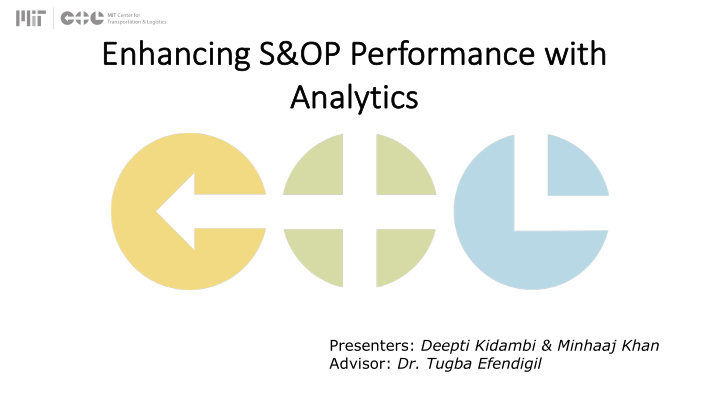



Enhanc Enhancing ing S S&OP P Per erformanc mance w e wit ith h An Analytics cs Presenters: Deepti Kidambi & Minhaaj Khan Advisor: Dr. Tugba Efendigil
Ag Agen enda • Introduction • Key Research Questions • Methodology • Results • Conclusion
In Introd oduct ction on S&OP process and risks to SC Nuances of the CPG Industry
In Introd oduct ction on • Sponsor and scope Profit Margin by 3.8%, $1.8MM • $17MM for the year •
Key Research Questions Ke 1 Can predictive analytics models effectively predict risk patterns in the S&OP plan? 2 How much can these models improve consensus forecast accuracy and what is the financial impact of this improvement? 3 What factors are important to the success of other CPG companies that want to pursue a similar risk assessment methodology in their S&OP plan?
Me Methodology - In Initiation on
Me Methodology - In Initiation on • Root Cause Analysis
Me Methodology - In Initiation on • Literature Review • E2OPEN (2016) Forecast Accuracy: Why It Matters and How To Improve It . Retrieved from https://www.e2open.com/resources/forecast-accuracy-why-it- matters-and-how-to-improve-it Chambers, J., Mullick, S., & Smith, D. (1971 Jul.) How to Choose the Right Forecasting Technique. Harvard Business Review. Retrieved from https://hbr.org • • Davenport, T. (2006) Competing on Analytics . Harvard Business Review. Retrieved from https://hbr.org • Hinkel, J., Merkel, O., & Kwasniok, T. (2016, Apr. 13) Good Sales and Operations Planning Is No Longer Good Enough . Retrieved from http://www.bain.com Myerholtz, B., & Caffrey, H. (2014, Nov. 4) Demand Forecasting: The Key to Better Supply-Chain Performance . Retrieved from https://www.bcg.com •
Me Methodology - Data a Preproc ocessin ssing
Me Methodology – Data a Preproc ocessin ssing Variable Correlation Heat Map • S&OP Excel files from Sep 2016-Nov 2017 • 2,477 records for a protein bar brand Predictors FullHorizonWOs CoV8 Variable Importance Plot PretoFullRatio MAD8Wks InitialIoH Min8Wks OHToFcstRatio Max8Wks Forecast Wk1-Wk4 EstimatedIoH Promo (unavailable)
Me Methodology – Ou Outcome Variables
Me Methodology – Ou Outcome Variables Outcome Variables Definition ForecastHighR (Forecast-ActualDemand)/Forecast > 0.5 • Forecast>100 • DemandHighR (ActualDemand-Forecast)/Forecast > 0.5 • Forecast>100 • ThresholdR WoS < 4-week threshold • StockoutR Weekly demand > Weekly supply across the • entire network
Me Methodology – Mo Modeling
Me Methodology – Mo Modeling • Historical Data • Algorithms “learn” • Predictions
Me Methodology – Qu Quanti tify y Be Benefit
Me Methodology – Mo Model Analysis Lift and Decile-wise Lift Chart Confusion Matrix (1) Logistic Regression Cutoff=.45 (2) k-nearest neighbors k=7 (3) Classification Trees Cutoff=.35 Reference Reference Reference Prediction 0 1 Prediction 0 1 Prediction 0 1 0 393 71 0 395 97 0 351 72 1 82 216 1 80 190 1 124 215 Accuracy Accuracy : 0.7992 Accuracy Accuracy : 0.6620 Accuracy Accuracy : 0.7428 P-Value P-Value : <2e-16 P-Value P-Value : <2e-16 P-Value : <1.819e-12 P-Value Sensitivity Sensitivity : .753 Sensitivity Sensitivity : .662 Sensitivity Sensitivity : .749 (4) Single Ensemble Cutoff=.35 (5) Average Ensemble (Model 1, 2 & 3) Cutoff=0.4 Reference Reference Prediction 0 1 Prediction 0 1 0 381 70 0 373 59 1 94 217 1 102 228 Accuracy Accuracy : 0.7848 Accuracy Accuracy : 0.7887 P-Value P-Value : <2e-16 P-Value P-Value : < 2.2e-16 Sensitivity Sensitivity : .756 Sensitivity Sensitivity : .794
Methodology – Mo Me Model Performance Comparison p-Value Forecast Accuracy Models ForecastHighR DemandHighR ThresholdR StockoutR Models ForecastHighR DemandHighR ThresholdR StockoutR (1)Logistic <2e-16 0.017 0.574 0.584 (1)Logistic 79.92% 82.53% 88.71% 72.51% Regression Regression (2)k-nearest <2e-16 5.70E-06 0.348 0.007 (2)k-nearest 66.20% 85.25% 89.37% 76.82% neighbors neighbors (3)Classification Tree 1.819E-12 0.109 0.807 0.132 (3)Classification Tree 74.28% 81.41% 87.93% 74.66% (4)Single Ensemble <2e-16 (4)Single Ensemble 78.48% (5)Average Ensemble <2e-16 (5)Average Ensemble 78.87% (Models 1, 2 & 3) (Models 1, 2 & 3) Sensitivity Models ForecastHighR DemandHighR ThresholdR StockoutR (1)Logistic 75.30% 28.50% 8.20% 6.90% Regression (2)k-nearest 66.20% 63.00% 15.30% 34.70% neighbors (3)Classification Tree 74.90% 35.00% 10.60% 29.70% (4)Single Ensemble 75.60% (5)Average Ensemble 79.40% (Models 1, 2 & 3)
Me Methodology – Qu Quanti tify y Bu Business Outp tput • Model Tested on S&OP Plans from Feb-Apr 2018 • Output from model (right) used for ForecastHighR risk mitigation
Me Methodology – Qu Quanti tify y Be Benefits ts Improvement in Model Accuracy & Bias Forecast Accuracy 5.7% • Accuracy Feb Mar Apr Total Baseline 50.4% 55.3% 44.8% 50.0% Predictive Model 54.1% 57.2% 55.8% 55.7% Bias near zero • Improvement 3.6% 1.9% 10.9% 5.7% Gross Profit $1.8MM • Bias Feb Mar Apr Total (protein bar brand) Baseline -1.0% 2.4% 8.5% 3.7% Predictive Model -3.9% -1.0% 3.4% -0.3% Increase of $17MM in annual gross profit
Co Conclusion 1 Supervised classification models effectively predict risks in the S&OP plan, even without big data. 2 Potential to deliver substantial improvement in forecast accuracy and gross profit . 3 Three steps to gain large increase in profit and competitive advantage: Capture planning data o Leverage predictive analytics o Buy in from key stakeholders o
Qu Ques estions? ? Presenters: Deepti Kidambi & Minhaaj Khan Advisor: Dr. Tugba Efendigil
Recommend
More recommend